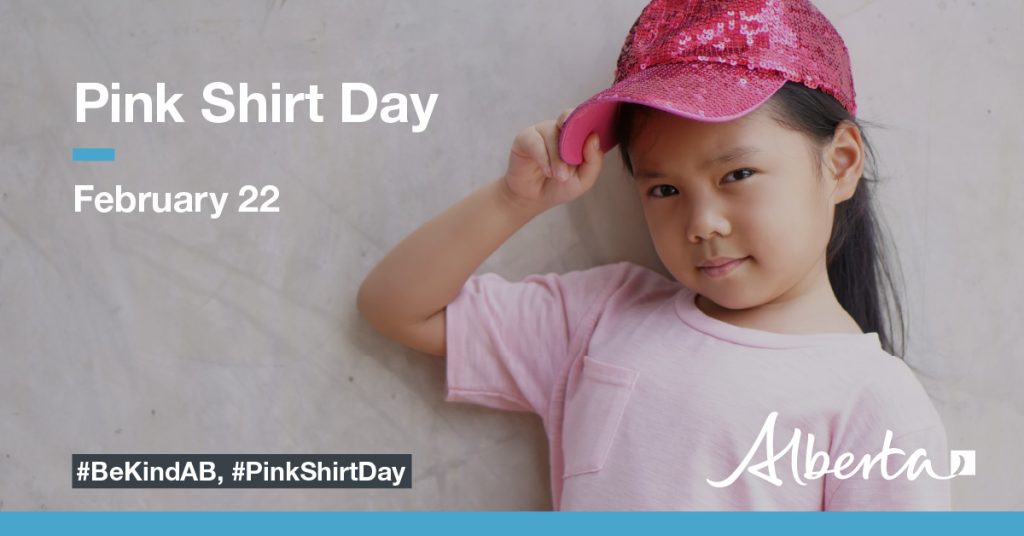Author: Onyinye Odih
Do parents recognize the signs of bullying in young children? We often think of bullying as behaviour that we see in teenagers, but even young children may use aggressive or bullying behaviours. And being bullied, or participating in bullying, can have negative effects on mental and social health.
Calgary Society for Healthy Child Development – Healthy Child YYC – recognizes the profound negative effects that bullying can have on healthy child development. We support Pink Shirt Day as a way to raise awareness about how to prevent bullying and to promote kindness and inclusion. Canada has declared the last Wednesday each February as Pink Shirt/Anti-bullying Day. For more information about Pink Shirt Day in Alberta, February 22, 2023.
First, a bit of history. Pink Shirt Day began in Canada in 2007 in a Nova Scotia High School. Classmates teased a new male student for wearing a pink shirt. Two grade 12 students decided to take action. They encouraged their classmates to wear pink; they even bought 50 pink shirts to share.
We asked Onyinye Odih, (Onyi) a mother, early childhood educator, and author; and a Director on our Board, to share her experience and advice for parents and childcare educators.
H.C. What are some signs that parents should watch for that their young child is being bullied or bullying others.?
Onyi: Children tend to handle things differently depending on their age and personality. It is therefore important that parents are very observant of changes in behaviour. Then carefully interpret the situation correctly so as to not confuse bullying with something else.
A child that is being bullied could:
- become very fearful and refuse to go to places of interest.
- offer to give up something they love doing just so that they are not in the same place as a bully.
- become quiet or reserved especially when they are dealing with the thoughts of being bullied and cannot or do not have anyone to express their feelings to.
Often parents cannot imagine their children as bullies. A question to consider – is your child’s action causing any of the above feelings for another child?
Here are some signs to spot, and to curb, to prevent your child from becoming a bully.
- Talking very rudely to others most of the time.
- Deliberately hurting another child and not caring that the child is hurt.
- Laughing at another child’s body part.
- Laughing at or teasing about colour choices (see Pink Shirt day Canada).
- Laughing at food choices.
- Laughing at hairstyles.
- Name-calling.
- Refusing to be in a team or group with a particular child
In many cases for young children under five, bullying can be unintentional. They require guidance from parents and caregivers; hence the need for quick intervention so that the behaviour does not progress.
H.C. What advice do you have for parents/childcare educators to prevent bullying and to promote kindness?
Onyi: Young children need guidance and while certain behaviours can be viewed as unacceptable for adults, children sometimes are unaware of this.
It takes practice for a young child to distinguish between acceptable and unacceptable behaviour. It is the responsibility of the adults in a child’s life to help provide clarity; this can make a difference in the choice children make when it comes to treating others with kindness.
To do this we might:
- Identify when they are “copying” a behaviour; young children learn from their peers. Helping a child to practice independence from a young age can be useful to prevent them for joining in the act of bullying.
- Spot an unusual behaviour in a child and speak to them privately about it. Speaking to a child privately about an unacceptable behaviour makes the child feel respected and better able to process the information they are receiving.
- Use group or circle time. As earlier stated, children learn from their peers. Educators can use group time or circle time to address bullying without directly speaking to a child. A child that is bullying others might learn from conversations with other children during circle time; that others do not approve of their behaviour.
As adults we might have success with addressing the issue of bullying when we find teachable moments. Try watching movies or reading books that give opportunity to talk about the subject.
For example, one movie that is appropriate for young children: The Ant Bully
H.C. Thank you Onyi. If readers want information related to teens, they can read your article:
Parents Beware: Bullying Can be Active or Passive.
Resources
Books to read to young children. With help from our guest author and Calgary Public Library staff, we have compiled a list for you to download. Books About Bullying
Links
Preschool Bullying: How to Help Article from the Australian Parenting Website with advice suitable for ages 3-5 years.
For more information about Pink Shirt Day in Alberta, February 22, 2023.
Videos online
Movies
With a free membership, you can sign up for Kanopy Kids through the Calgary Public Library. The staff will help you find age-appropriate movies/videos about bullying and teaching kindness and empathy to young children.


Pingback: Raising Boys - Healthy Child YYC